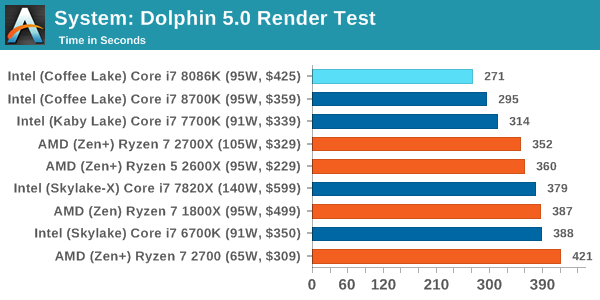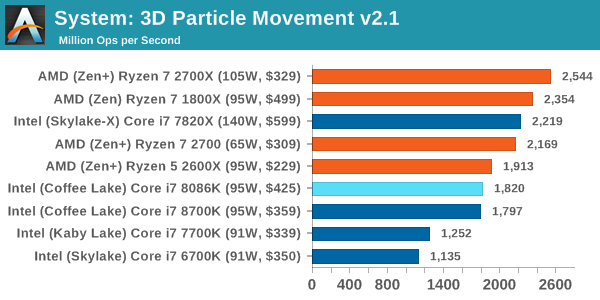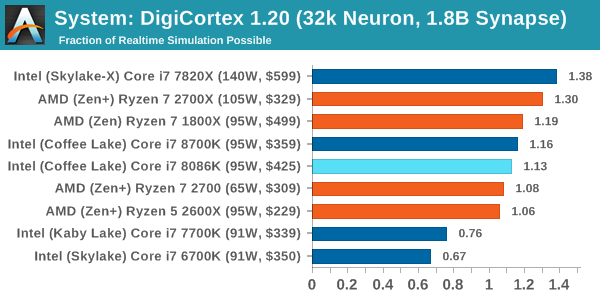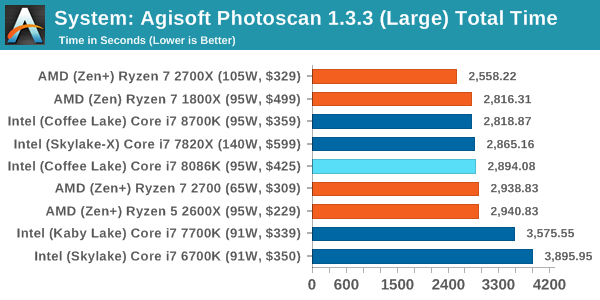The Intel Core i7-8086K Review
by Ian Cutress on June 11, 2018 8:00 AM EST- Posted in
- CPUs
- Intel
- Core i7
- Anniversary
- Coffee Lake
- i7-8086K
- 5 GHz
- 8086K
- 5.0 GHz
Benchmarking Performance: CPU System Tests
Our first set of tests is our general system tests. These set of tests are meant to emulate more about what people usually do on a system, like opening large files or processing small stacks of data. This is a bit different to our office testing, which uses more industry standard benchmarks, and a few of the benchmarks here are relatively new and different.
All of our benchmark results can also be found in our benchmark engine, Bench.
FCAT Processing: link
One of the more interesting workloads that has crossed our desks in recent quarters is FCAT - the tool we use to measure stuttering in gaming due to dropped or runt frames. The FCAT process requires enabling a color-based overlay onto a game, recording the gameplay, and then parsing the video file through the analysis software. The software is mostly single-threaded, however because the video is basically in a raw format, the file size is large and requires moving a lot of data around. For our test, we take a 90-second clip of the Rise of the Tomb Raider benchmark running on a GTX 980 Ti at 1440p, which comes in around 21 GB, and measure the time it takes to process through the visual analysis tool.

FCAT is single threaded, however in this test the full 5.0 GHz did not kick in.
Dolphin Benchmark: link
Many emulators are often bound by single thread CPU performance, and general reports tended to suggest that Haswell provided a significant boost to emulator performance. This benchmark runs a Wii program that ray traces a complex 3D scene inside the Dolphin Wii emulator. Performance on this benchmark is a good proxy of the speed of Dolphin CPU emulation, which is an intensive single core task using most aspects of a CPU. Results are given in minutes, where the Wii itself scores 17.53 minutes.

For a test that did have 5.0 GHz kick in, the 8086K takes the record in our Dolphin test.
3D Movement Algorithm Test v2.1: link
This is the latest version of the self-penned 3DPM benchmark. The goal of 3DPM is to simulate semi-optimized scientific algorithms taken directly from my doctorate thesis. Version 2.1 improves over 2.0 by passing the main particle structs by reference rather than by value, and decreasing the amount of double->float->double recasts the compiler was adding in. It affords a ~25% speed-up over v2.0, which means new data.

On 3DPM, the 8086K shows that the 4.3 GHz all-core is on par with the 8700K.
DigiCortex v1.20: link
Despite being a couple of years old, the DigiCortex software is a pet project for the visualization of neuron and synapse activity in the brain. The software comes with a variety of benchmark modes, and we take the small benchmark which runs a 32k neuron/1.8B synapse simulation. The results on the output are given as a fraction of whether the system can simulate in real-time, so anything above a value of one is suitable for real-time work. The benchmark offers a 'no firing synapse' mode, which in essence detects DRAM and bus speed, however we take the firing mode which adds CPU work with every firing.

Despite the faster single core frequency, this DRAM-limited test seems to load up another core and stops the 8086K from reaching 5.0 GHz.
Agisoft Photoscan 1.3.3: link
Photoscan stays in our benchmark suite from the previous version, however now we are running on Windows 10 so features such as Speed Shift on the latest processors come into play. The concept of Photoscan is translating many 2D images into a 3D model - so the more detailed the images, and the more you have, the better the model. The algorithm has four stages, some single threaded and some multi-threaded, along with some cache/memory dependency in there as well. For some of the more variable threaded workload, features such as Speed Shift and XFR will be able to take advantage of CPU stalls or downtime, giving sizeable speedups on newer microarchitectures.

Agisoft is variable threaded, but the 8086K is still a small stones throw from the 8700K.










111 Comments
View All Comments
Oxford Guy - Thursday, June 14, 2018 - link
Welcome to marketing — land of emotion.twtech - Tuesday, June 12, 2018 - link
It seems like the only good reason to buy this processor would be for the preferential binning - it's kind of like a manufacturer official version of Silicon Lottery.xpto - Thursday, June 14, 2018 - link
New Vulnerability hits Intel processors - Lazy FP State Restorehttps://www.intel.com/content/www/us/en/security-c...
jarf1n - Thursday, June 14, 2018 - link
well i know and few more that anatech are and clear long time amd support and cant make test without raise amd gpus and cpus someway better.sad...
but we are not idiots
its clear that both 6-core cpus 870k0 and 8086 are much better cpus than amds 8-core ryzen 2700x. that is clear fact
2700x is 8-core and still loose 3dmarks what is historical.. bcoz never bfore cpu that own more cores LOOSE cpu wich have less them.
its tell clear that ryzen 2700x is weak and also mem problem show it.
2700x cant handle high timing and hertz,
2700x is better and really shod be for mathematic apz,but as i say ITS 8-CORE CPU.
still it loose many test.
and for thouse importants games and 3dmarks its loose and clear.
when intels ALSO 8-core cpu guess 9700k release we really see how bad 2700z is.
i can say that 8-core 2700x loose clear for intels 9700k 8-core cpu.
ok..then 6700k vs 8086 cpu
well its clear that 8086 is better than 8700k,bcoz 8086 is hand picket cpus and oc'd better than 8700k.
so its mean 8086 ov'c higher,running lower heat ...exmaple all 8086 ov'd easily 5ghz, many 8700k not. only best.. and i took 24/7 use.
sure if you get good 8700k its different,but if different is example anatech saying 75$ that i can get good cpu i pay it for joy!
if you want best gaming rig buy:
asus hero x
2x8gb 4000mhz cl17 mem
8086 or 8700k cpu and ocäd it about 5ghz
buy more nvidia gtx 1080 ti
then u have gaming rig that amd cant beat near 2 years...think about it...
gtx 1080 ti is old shit and amd vega only few month old still no chance.
xpto - Monday, June 18, 2018 - link
https://www.amd.com/en/campaigns/threadripper-exch...alpha754293 - Tuesday, June 19, 2018 - link
FYI - On the overclocking CPU page - GeekBench MT chart is a duplicate of the CineBench MT chart.sarahberard - Wednesday, June 20, 2018 - link
Hello I am so delighted I located your blog, I was watching on google for something else, greatsarahberard - Wednesday, June 20, 2018 - link
Your site fantastic, superior quality succeed... http://best-penis-pump.com/">.none12345 - Thursday, June 21, 2018 - link
I wasnt expecting much out of the 8086k over the 8700k... but this is truely underwhelming. Only a single core turbo boost? I was expecting all the boost tiers to be higher. And same tdp....so there goes it doing anything more at stock.I wasnt going to buy one anyway....so i guess it doesnt matter. I completely agree that intel could have and should have done more.
Thests - Sunday, November 17, 2019 - link
Ich frage mich, wie schnell der technologische Fortschritt voranschreitet. Der nächste Schritt ist das Streamen von einem Online-Casino, beispielsweise über https://casinoonlineschweiz24.com/software/merkur-... Es wird für alle Glücksspielenthusiasten mega aufregend sein